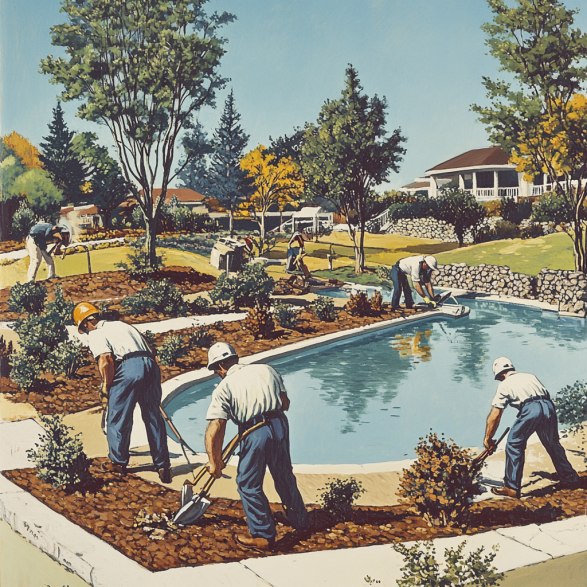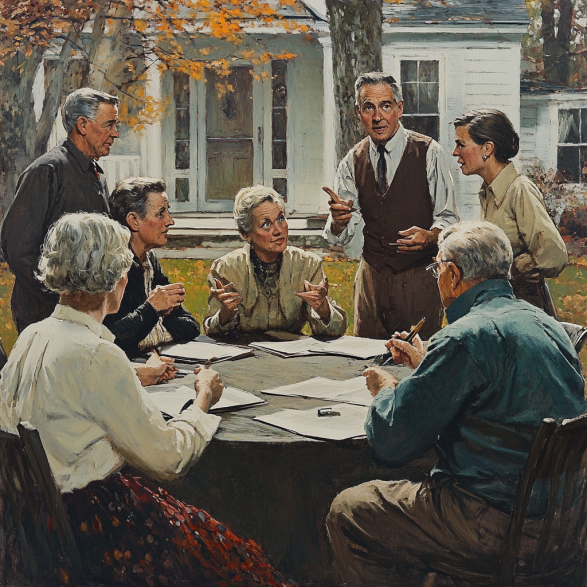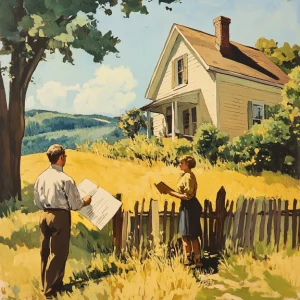Ah, the Homeowners Association (HOA)! Just the mention of it might have you rolling your eyes or heaving a sigh of resignation. For many, the term HOA is synonymous with strict rules, unexpected fees, and that one neighbor who always seems to be in charge. But what if I told you there’s a way to not just get by but to actually enjoy your HOA? Yes, you heard me right. It’s about flipping the script, from seeing an overbearing overseer to recognizing a valuable ally in preserving your home’s value and enhancing your community living experience.
This guide is your roadmap from frustration to appreciation, a journey to understand the misunderstood. So, buckle up! We’re about to dive deep into the world of HOAs, debunking myths, uncovering benefits, and learning how to navigate the waters of community management with ease and confidence.
1. What is an HOA?
A homeowners association (HOA) is a critical entity within residential communities, particularly in subdivisions, planned communities, and condominiums. It acts as the backbone of the community, ensuring that the neighborhood remains orderly, aesthetically pleasing, and well-maintained. When you purchase a property in an HOA-governed community, you automatically become a member of the association. This membership is not merely symbolic; it carries with it a set of responsibilities and benefits designed to uphold the community’s standards and enhance the quality of life for all residents. The primary role of an HOA is to enforce community rules, maintain common areas, and manage shared amenities like pools, parks, and clubhouses. These responsibilities are crucial for keeping the community attractive and functional, which in turn helps to maintain or even increase property values over time.
The operation of an HOA is structured around a set of governing documents, which include Covenants, Conditions, and Restrictions (CC&Rs), bylaws, and rules and regulations. The CC&Rs are foundational documents that outline the specific guidelines homeowners must adhere to, covering everything from the appearance of your home and yard to restrictions on exterior modifications and the use of shared spaces. The bylaws dictate how the HOA itself is governed, including the procedures for electing board members, how meetings are conducted, and how decisions are made. The rules and regulations focus on the day-to-day operations of the community, ensuring that everyone abides by the agreed-upon standards, which helps to prevent conflicts and promote harmony among residents.
The board of directors, usually composed of elected volunteer homeowners, plays a pivotal role in the functioning of the HOA. This board is responsible for enforcing the rules set out in the governing documents, managing the association’s finances, and ensuring that the community’s needs are met. The board oversees the collection of HOA dues, which are mandatory fees paid by all homeowners. These funds are used to maintain common areas, such as landscaping, recreational facilities, and infrastructure, as well as to organize community events and activities that foster a sense of belonging among residents. Additionally, the board handles any issues that arise within the community, from disputes between neighbors to larger concerns about the neighborhood’s overall upkeep. By facilitating regular meetings and maintaining open lines of communication with residents, the board ensures that the community operates smoothly and that homeowners have a voice in how their neighborhood is managed. Ultimately, the HOA serves as a steward of the community, working to create a safe, attractive, and desirable place to live while protecting and potentially enhancing the value of each property within its jurisdiction.
2. Homeowners Association Governing Documents
The backbone of any homeowners association (HOA) lies in its governing documents. These documents are crucial because they define the legal framework that governs the community, setting out the rules and expectations for both the homeowners and the association itself. Without these documents, there would be no standardized way to ensure that the community remains orderly, attractive, and functional. Here’s a deeper dive into the main components of HOA governing documents:
1. Declarations of Covenants, Conditions, and Restrictions (CC&Rs)
- The Declarations of Covenants, Conditions, and Restrictions, commonly referred to as CC&Rs, are the cornerstone of the HOA’s legal authority. Think of the CC&Rs as the community’s rulebook. These documents spell out what homeowners can and cannot do with their properties. For example, the CC&Rs may set guidelines on architectural standards—such as the types of exterior modifications you can make to your home, the materials you can use, and the overall aesthetic that the community should maintain. The CC&Rs might also dictate land use restrictions, like prohibiting certain types of businesses from being run out of homes or setting limits on the number of vehicles that can be parked on the property.
- The CC&Rs are designed to maintain a cohesive look and feel within the community, helping to preserve property values and ensure that one homeowner’s actions do not negatively impact the neighborhood as a whole. Importantly, the CC&Rs are legally binding; when you purchase a property within an HOA, you agree to abide by these rules. Violations can result in fines or other enforcement actions by the HOA, making it critical for homeowners to understand and follow these guidelines.
2. Bylaws
- While the CC&Rs focus on what homeowners can do, the bylaws focus on how the HOA itself operates. The bylaws are essentially the operational manual for the HOA, outlining the structure and function of the association. This includes details on how board members are elected, how long they serve, and what their responsibilities are. The bylaws also dictate how often meetings should be held, how decisions are made, and the process for amending rules.
- The bylaws ensure that the HOA is run in a transparent, democratic manner, providing a clear framework for leadership and decision-making. For instance, they might specify the quorum required for meetings, the voting process for major decisions, and the procedures for resolving conflicts within the board. Understanding the bylaws is crucial for any homeowner who wants to get involved in the HOA, whether by attending meetings, voting on issues, or even serving on the board.
3. Rules and Regulations
- Derived from the CC&Rs, the rules and regulations are more specific and often deal with the day-to-day aspects of living in the community. These guidelines help to manage the practicalities of communal living, addressing issues that might arise frequently in a neighborhood setting. For example, rules and regulations might cover parking—specifying where residents and their guests can park, or how long vehicles can remain in a certain spot. They might also address noise levels, setting quiet hours to ensure that all residents can enjoy their homes without disruption.
- Pet policies are another common focus of the rules and regulations, detailing how many pets a homeowner can have, the types of pets allowed, and any leash or waste disposal requirements. These rules are designed to create a pleasant and orderly living environment for everyone in the community. While they are often more flexible than the CC&Rs, violations of the rules and regulations can still result in fines or other penalties.
In summary, the governing documents of an HOA are essential for maintaining the structure, harmony, and aesthetic appeal of a community. They protect homeowners’ investments by ensuring that everyone follows the same guidelines, and they provide a clear framework for the association’s operations. Understanding these documents is key to not only complying with community standards but also participating effectively in the HOA’s governance.

3. Who Makes Up an HOA?
An HOA is made up of various groups and individuals, each playing a crucial role in keeping the community running smoothly. Here’s who’s involved:
Homeowners
Every property owner within the community is a member of the HOA. As a homeowner, you have the right to vote on important matters, attend meetings, and even run for positions on the HOA board. Essentially, homeowners are the backbone of the HOA, and your participation is key to how effectively it functions.
HOA Board of Directors
The HOA board is composed of elected homeowners who volunteer their time to manage the association’s affairs. These board members typically serve for a specified term and make decisions on behalf of the community. The board is responsible for enforcing the CC&Rs, collecting dues, and managing the budget. Here’s a quick rundown of typical roles on the board:
- President: The president leads the board, sets meeting agendas, and represents the HOA in official matters.
- Vice President: The vice president supports the president and steps in if the president is unavailable.
- Treasurer: The treasurer handles the HOA’s finances, including budgets, dues collection, and financial reporting.
- Secretary: The secretary keeps meeting minutes, maintains records, and manages correspondence.
HOA Committees
Many HOAs have specialized committees focused on specific areas, such as landscaping, architectural review, social events, and security. These committees are often made up of volunteer homeowners and report to the board. Committees help distribute the workload and bring diverse perspectives to the table. Examples include:
- Architectural Committee: Reviews and approves exterior modifications to homes to ensure they comply with community standards.
- Landscaping Committee: Oversees the maintenance and enhancement of common areas and green spaces.
- Social Committee: Organizes community events and activities to foster neighborly connections.
Property Management Company
Some HOAs hire a property management company to handle day-to-day operations like maintenance, dues collection, and rule enforcement. This can take a load off the board, allowing them to focus on bigger picture decisions. The property management company acts as a liaison between the board and homeowners, ensuring the community runs smoothly.
Vendors and Service Providers
The HOA often contracts with vendors and service providers for tasks like landscaping, pool maintenance, trash collection, and security. These providers are selected and overseen by the board or the property management company. By outsourcing these tasks, the HOA can ensure they’re handled professionally and efficiently.
4. How Does an HOA Function?
An HOA functions best when all these components work together harmoniously. Here’s a snapshot of how things typically operate:
- Board Meetings: The board holds regular meetings where members discuss community issues, review committee reports, and make decisions. Homeowners are encouraged to attend these meetings to stay informed and provide input.
- Annual General Meetings (AGMs): These are larger meetings where all homeowners are invited to hear updates on the community, vote on major decisions, and elect board members.
- Communication: Newsletters, emails, and community websites are common tools used by the HOA to keep homeowners informed about upcoming events, changes to rules, and other important information.
5. Pros and Cons of HOAs

Now that we’ve covered the basics, let’s dive into the pros and cons of living in an HOA-managed community.
Pros of HOAs
- Maintenance and Upkeep of Common Areas
- Pro: HOAs ensure that common areas such as parks, swimming pools, clubhouses, and landscaping are well-maintained. This keeps the neighborhood looking attractive and functional, contributing to a higher quality of life for residents.
- Enhanced Property Values
- Pro: By enforcing rules and maintaining common areas, HOAs help preserve property values. Homes in well-kept communities are generally more attractive to buyers, which can increase the resale value of your property.
- Access to Amenities
- Pro: Many HOAs offer amenities that would be costly for individual homeowners to maintain on their own, such as swimming pools, fitness centers, tennis courts, and community centers. These amenities enhance the living experience and provide recreational options for residents.
- Conflict Resolution
- Pro: HOAs provide a structured process for resolving disputes between neighbors, which can help maintain peace and order in the community. This can prevent minor disagreements from escalating into major conflicts.
- Community Building
- Pro: HOAs often organize events and activities that foster a sense of community and encourage neighborly interaction. This can make the neighborhood feel more welcoming and cohesive.
- Professional Management
- Pro: Some HOAs hire professional management companies to handle administrative tasks, maintenance, and enforcement of rules. This professional oversight can lead to more efficient and effective community management.
Cons of HOAs
- Mandatory Fees
- Con: HOA fees can be a significant additional expense for homeowners. These fees are mandatory and typically increase over time to cover rising maintenance and operational costs.
- Strict Rules and Regulations
- Con: HOAs enforce a set of rules and guidelines that homeowners must follow, which can sometimes feel restrictive. These rules can cover everything from the color of your house to where you can park your car.
- Potential for Conflict
- Con: Disagreements can arise between homeowners and the HOA board, particularly over rule enforcement, fees, and community management decisions. This can lead to tension and, in some cases, legal disputes.
- Limited Autonomy
- Con: Living in an HOA community means that homeowners have less autonomy over their property. Any modifications or changes to the exterior of the home often require approval from the HOA, which can be frustrating for some residents.
- Board Dynamics
- Con: The effectiveness of an HOA can heavily depend on the board members, who are typically volunteers from the community. If the board is not well-organized or if there are power struggles, it can negatively impact the community.
- Legal and Financial Risks
- Con: Mismanagement of HOA funds or failure to enforce rules can lead to legal and financial problems for the community. Homeowners might end up bearing the cost of lawsuits or special assessments to cover unforeseen expenses.
6. Balancing the Pros and Cons
Living in an HOA community has its benefits and drawbacks. The key to making the most of your HOA experience is understanding these pros and cons and actively participating in the community. By getting involved, attending meetings, and communicating with the board, homeowners can help shape a positive living environment and address any concerns that arise.
7. Navigating HOA Management
Navigating HOA management might seem daunting at first, but it becomes easier when you remember that the HOA isn’t some external force. It’s made up of your neighbors and fellow homeowners. Here’s how you can shift your perspective and actively contribute to a better community experience:
- The Backbone of the Community
- The HOA is a collective of homeowners, including you. Understanding this helps shift your perspective from seeing the HOA as a burden to recognizing it as a community effort to maintain and improve your living environment.
- Active Participation Is Key
- You’ve probably heard the saying, “If you’re not at the table, you’re on the menu.” This applies to HOAs too. By getting involved, whether through attending meetings, voting, or even joining the board, you have a say in decisions that affect your living environment.
- Understanding Your HOA Management
- Effective communication is less about talking and more about engaging. Attend meetings, read the newsletters, and when in doubt, ask. Don’t be afraid to voice your concerns or suggestions—constructive feedback helps improve the community for everyone.
- Influencing Decisions
- Influencing decisions might sound daunting, but it often starts with simply showing up. Whether it’s voting in elections or volunteering for a committee, your involvement can steer the community in a positive direction.

Conclusion
In wrapping up, our journey from HOA skepticism to appreciation shows that understanding, involvement, and communication are key. With this guide, you’re not just equipped to survive your HOA but to thrive within it. Remember, a harmonious relationship with your HOA doesn’t just benefit your community—it enhances your quality of life. By taking an active role and fostering open communication, you can turn your HOA experience into one that’s positive and fulfilling.
FAQs
What if I disagree with an HOA decision?
A: If you disagree with a decision, attend the next board meeting to voice your concerns. You can also communicate directly with the board through written correspondence. It’s important to approach the situation calmly and constructively.
How can I reduce my HOA fees?
A: Reducing HOA fees is typically a community-wide effort. You can propose cost-saving measures at meetings, such as renegotiating contracts with vendors or cutting back on non-essential services.
Can I opt out of my HOA?
A: Opting out of an HOA is generally not possible if you live in a community governed by one. Membership in the HOA is usually mandatory for all homeowners within the development. However, you can work within the system to make positive changes.




